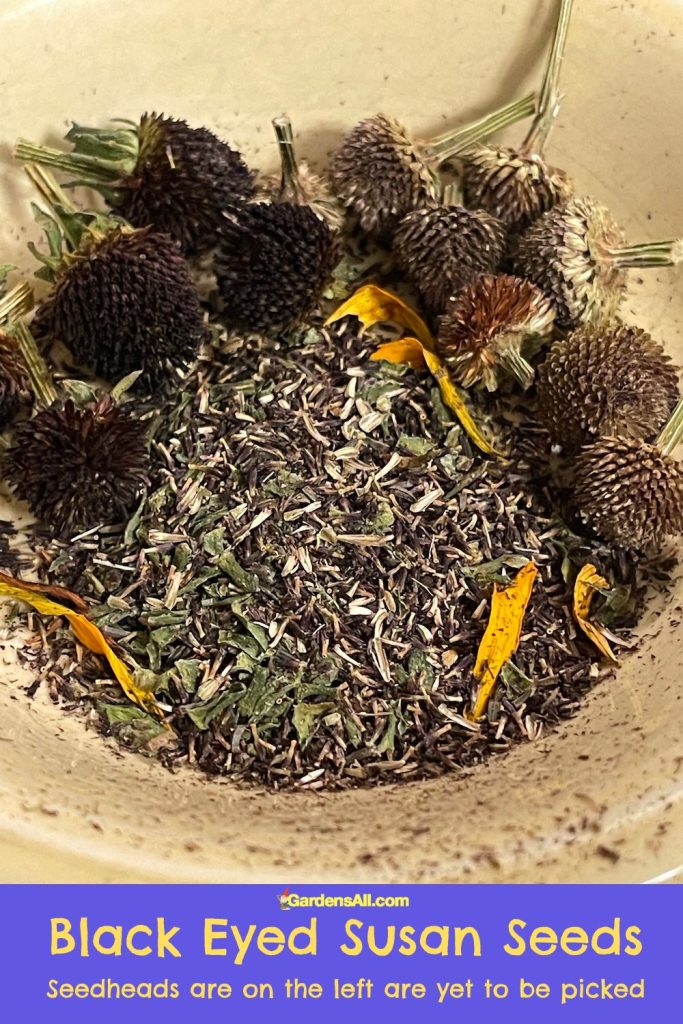When we shared on Facebook our article on the medicinal uses of Black Eyed Susan, a friend’s response inspired us to write this article. Shannon said she loves growing them for her bees and her mom and herself, and in fact, she’s planning to do Black Eyed Susan seed harvesting in order to spread them along her woodline.
Black Eyed Susans (Rudbeckia hirta) are cheerful, yellow daisy-like flowers with a dark brown or black center. Not only do they brighten up landscapes and gardens, but they are also beneficial for pollinators like bees and butterflies.
If you’re also charmed by these delightful blossoms, you may also be interested in Black Eyed Susan seed harvesting and propagating.
Shannon said, “I’m taking the seed pods and spreading them along the woodline.”
All About Black Eyed Susan Seeds
Black Eyed Susans will produce seed heads after the flowers fade, typically in late summer or early fall.
Seed Harvesting
- When to Harvest: Wait until the petals fall off and the center cone becomes dark brown.
- Collection: Using garden scissors, snip off the seed heads and place them in a paper bag, garden harvest basket or box.
- Dry to insure the seeds are mold free. You can air dry or machine dry.
- Air Dry: Allow the seed heads to dry in a well-ventilated area for a week. You can air dry them by:
- clip or tie flower seed heads to a clothes line under shelter from rain
- place in a paper bag and hang bag or place in a well-ventilated area
- Dehydrator: place in a dehydrator for 4-24 hours. Check after 4-8 hours and if not yet dry, continue until crisply dry.
- Air Dry: Allow the seed heads to dry in a well-ventilated area for a week. You can air dry them by:
- Extraction:
- Once dried, rub the seed heads between your fingers or against a fine mesh sieve to release the tiny, dark seeds.
- Separate the seeds from any chaff or plant debris.
- Storage:
- Store the seeds in a paper envelope or airtight container in a cool, dark place. If stored properly, they can remain viable for up to two years.

Germination
- Cold Stratification: Black Eyed Susan seeds benefit from a period of cold stratification, which means mimicking winter conditions to break dormancy. Place the seeds in a plastic bag with a slightly moistened paper towel or sand and refrigerate for about 4 weeks before planting.
- Starting Indoors: About 6-8 weeks before the last expected frost, sow seeds in seed trays or pots filled with a seed-starting mix. Cover them lightly with soil as they require some light to germinate.
- Temperature and Lighting: Maintain a temperature of 70°F (21°C) and ensure they get adequate light. Using a grow light can be beneficial.
- Watering: Keep the soil consistently moist but not soggy. Using a spray bottle can help maintain moisture without overwatering.
- Seedling Care: Once seedlings develop two sets of true leaves, they can be transplanted into bigger pots or hardened off to prepare for outdoor planting.
When to Plant Black Eyed Susan Seed
Black Eyed Susans are versatile and forgiving, which makes planting their seeds relatively straightforward. However, for optimal growth, timing is essential.
- Direct Outdoor Sowing:
- Spring: As soon as the threat of frost has passed, you can sow Black Eyed Susan seeds directly outdoors. This typically corresponds to late spring in most regions.
- Fall: An often-overlooked time to plant is in fall, about 2-4 weeks before the first expected frost. Fall planting allows for nature’s natural stratification process to take place during winter, resulting in germination the following spring.
See Frost Dates information for your area.
- Indoor Sowing:
- Start the seeds indoors 6-8 weeks before the last expected frost date. Once the threat of frost has passed and seedlings are hardy, they can be transplanted outdoors.
Planting
- Site Selection: Choose a site that receives full sun to partial shade. Black Eyed Susans are adaptable but thrive in well-draining soil.
- Spacing: Plant seedlings or seeds about 12-18 inches apart to give them room to grow and spread.
- Watering: Water regularly until plants are established. Once mature, Black Eyed Susans are drought-tolerant and require minimal watering.
- Mulching: Applying a layer of mulch around the base can help retain moisture, prevent weeds, and keep the roots cool.
- Fertilizing: While these plants aren’t particularly demanding, applying a balanced slow-release fertilizer in the spring can promote vigorous growth.


You may also enjoy reading about black eyed susan medicinal uses and benefits of echinacea.
Black Eyed Susans are a brilliant addition to any garden, offering bursts of color from summer to fall. By harvesting and germinating their seeds, you can not only save money but also share these beauties with friends and family. With the right care, these vibrant perennials will flourish and brighten up your outdoor space for years to come.
I’m LeAura Alderson, a garden, herb and plant enthusiast with a passion for discovering the many edible and medicinal benefits of the plants all around us, including the weeds! I’m a writer, editor and media publisher for our family of websites.
While I was certified in fitness and life coaching, I am NOT a health practitioner. However, I’m a lifelong health enthusiast, with a keen interest in healthy, organic foods and making home remedies and the content we share is from our own experience and usage as well as that extracted from scientific research so that you can explore further on your own.
Always seek the advice and guidance of your health practitioners first and foremost.
As a family we’re steadily expanding our gardening, experimentation and knowledge around all things gardening, edible landscaping, fresh organic foods and self sustainability with farming in our future. I also own and manage iCreateDaily.com, a site all about transformation through creation, and the power of positivity, optimism and mindset.

